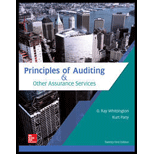
Principles Of Auditing & Other Assurance Services
21st Edition
ISBN: 9781259916984
Author: WHITTINGTON, Ray, Pany, Kurt
Publisher: Mcgraw-hill Education,
expand_more
expand_more
format_list_bulleted
Question
Chapter 9, Problem 10RQ
To determine
Explain the source of estimation in the attributes sampling.
Expert Solution & Answer
Want to see the full answer?
Check out a sample textbook solution
Students have asked these similar questions
What is the relationship between sample size and (a) sampling risk, (b) tolerable rate of deviation,and (c) expected population deviation rate
Which of the following best describes the method of determining the ULRD?a. Expected population deviation rate + Allowance for sampling risk.b. Risk of underreliance + Allowance for sampling risk.c. Sample rate of deviation + Allowance for sampling risk.d. Tolerable rate of deviation + Allowance for sampling risk.
Which of the following statistical techniques are used to test controls?
Mean-per-unit sampling.
Attribute sampling.
Difference estimation.
Ratio estimation.
Chapter 9 Solutions
Principles Of Auditing & Other Assurance Services
Ch. 9 - Prob. 1RQCh. 9 - Prob. 2RQCh. 9 - Prob. 3RQCh. 9 - Prob. 4RQCh. 9 - Prob. 5RQCh. 9 - Prob. 6RQCh. 9 - Prob. 7RQCh. 9 - Prob. 8RQCh. 9 - Prob. 9RQCh. 9 - Prob. 10RQ
Ch. 9 - Prob. 11RQCh. 9 - Prob. 12RQCh. 9 - What is a dual-purpose test?Ch. 9 - Prob. 14RQCh. 9 - Prob. 15RQCh. 9 - Prob. 16RQCh. 9 - What would be the difference between an attributes...Ch. 9 - Prob. 18RQCh. 9 - Prob. 19RQCh. 9 - Prob. 20RQCh. 9 - Prob. 21RQCh. 9 - Prob. 22RQCh. 9 - Prob. 23RQCh. 9 - Prob. 24RQCh. 9 - Prob. 25RQCh. 9 - Prob. 26RQCh. 9 - Prob. 27RQCh. 9 - Prob. 28RQCh. 9 - Prob. 29QRACh. 9 - Prob. 30QRACh. 9 - Prob. 31QRACh. 9 - Prob. 32QRACh. 9 - Prob. 33QRACh. 9 - Prob. 34QRACh. 9 - Prob. 35QRACh. 9 - Prob. 36QRACh. 9 - Prob. 37AOQCh. 9 - Prob. 37BOQCh. 9 - Prob. 37COQCh. 9 - Prob. 37DOQCh. 9 - Prob. 37EOQCh. 9 - Prob. 37FOQCh. 9 - Prob. 37GOQCh. 9 - Prob. 37HOQCh. 9 - Prob. 37IOQCh. 9 - Prob. 37JOQCh. 9 - Prob. 37KOQCh. 9 - Prob. 37LOQCh. 9 - Prob. 38OQCh. 9 - Prob. 39OQCh. 9 - For each term in the first column below, identify...Ch. 9 - Prob. 41OQCh. 9 - Smith, Inc. Rachel Robertson wishes to use...Ch. 9 - Prob. 43OQCh. 9 - Prob. 44PCh. 9 - Prob. 45PCh. 9 - Prob. 46PCh. 9 - Prob. 47PCh. 9 - In the audit of Potomac Mills, the auditors wish...Ch. 9 - Prob. 49PCh. 9 - Prob. 50PCh. 9 - Prob. 51PCh. 9 - Prob. 52ITC
Knowledge Booster
Similar questions
- 1. Which of the following would be designed to estimate a numerical measurement of a population, such as monetary value?* A. Sampling for variables B. Sampling for attributes C. Sequential sampling D. Discovery sampling E. None of themarrow_forwardA principal advantage of statistical methods of attribute sampling over nonstatistical methods is that they provide a scientific basis for planning the A. risk of overreliance B. tolerable rate C. expected population deviation rate D. Sample sizearrow_forwardIdentify differences between the determination of sample size under classical variables samplingand MUS.arrow_forward
- The risk that the decision made based on the sample will differ from the decision madebased on the entire population is referred to asa. Audit risk.b. Examination risk.c. Sampling risk.d. Nonsampling riskarrow_forwardWhat is the formula for Audit Sampling?arrow_forwardWhich of the following components of the audit risk model is most closely associated with attributes sampling?a. Audit risk.b. Control risk.c. Detection risk.d. Inherent risk.arrow_forward
- What factors affect sample size?arrow_forwardSubject: Auditing & Assurance Principles Define the following factors that affect the determination of sample size: a) Acceptable sampling risk b) Tolerable deviation rate c) Expected deviation rate d) Tolerable misstatement e) Expected misstatement f) Variation in the populationarrow_forwardThe interpretation of the ULRD in an attributes sampling application isa. The estimated rate of deviation in the population with probability equal to the risk ofoverreliance that the population deviation rate is higher.b. The estimated rate of deviation in the population with probability equal to the risk ofoverreliance that the actual rate of deviation is lower.c. The estimated rate of deviation in the population with certainty that the actual rate ofdeviation is lower.d. The estimated rate of deviation in the population with certainty that the actual rate ofdeviation is higher.arrow_forward
- The distance from the sample estimate that has a certain likelihood (equal to reliability) ofincluding the true population value is known as thea. Confidence.b. Mean.c. Precision.d. Precision interval.arrow_forwardSubject: Auditing & Assurance Principles Differentiate the following: a) Statistical vs Non-statistical sampling b) Attribute vs Variables samplingarrow_forwardWhich of the following pairs of selection methods could appropriately be used in statistical sampling applications?a. Unrestricted random selection, block selection.b. Block selection, haphazard selection.c. Systematic random selection, haphazard selection.d. Unrestricted random selection, systematic random selection.arrow_forward
arrow_back_ios
SEE MORE QUESTIONS
arrow_forward_ios
Recommended textbooks for you
 Auditing: A Risk Based-Approach to Conducting a Q...AccountingISBN:9781305080577Author:Karla M Johnstone, Audrey A. Gramling, Larry E. RittenbergPublisher:South-Western College Pub
Auditing: A Risk Based-Approach to Conducting a Q...AccountingISBN:9781305080577Author:Karla M Johnstone, Audrey A. Gramling, Larry E. RittenbergPublisher:South-Western College Pub Auditing: A Risk Based-Approach (MindTap Course L...AccountingISBN:9781337619455Author:Karla M Johnstone, Audrey A. Gramling, Larry E. RittenbergPublisher:Cengage Learning
Auditing: A Risk Based-Approach (MindTap Course L...AccountingISBN:9781337619455Author:Karla M Johnstone, Audrey A. Gramling, Larry E. RittenbergPublisher:Cengage Learning

Auditing: A Risk Based-Approach to Conducting a Q...
Accounting
ISBN:9781305080577
Author:Karla M Johnstone, Audrey A. Gramling, Larry E. Rittenberg
Publisher:South-Western College Pub

Auditing: A Risk Based-Approach (MindTap Course L...
Accounting
ISBN:9781337619455
Author:Karla M Johnstone, Audrey A. Gramling, Larry E. Rittenberg
Publisher:Cengage Learning